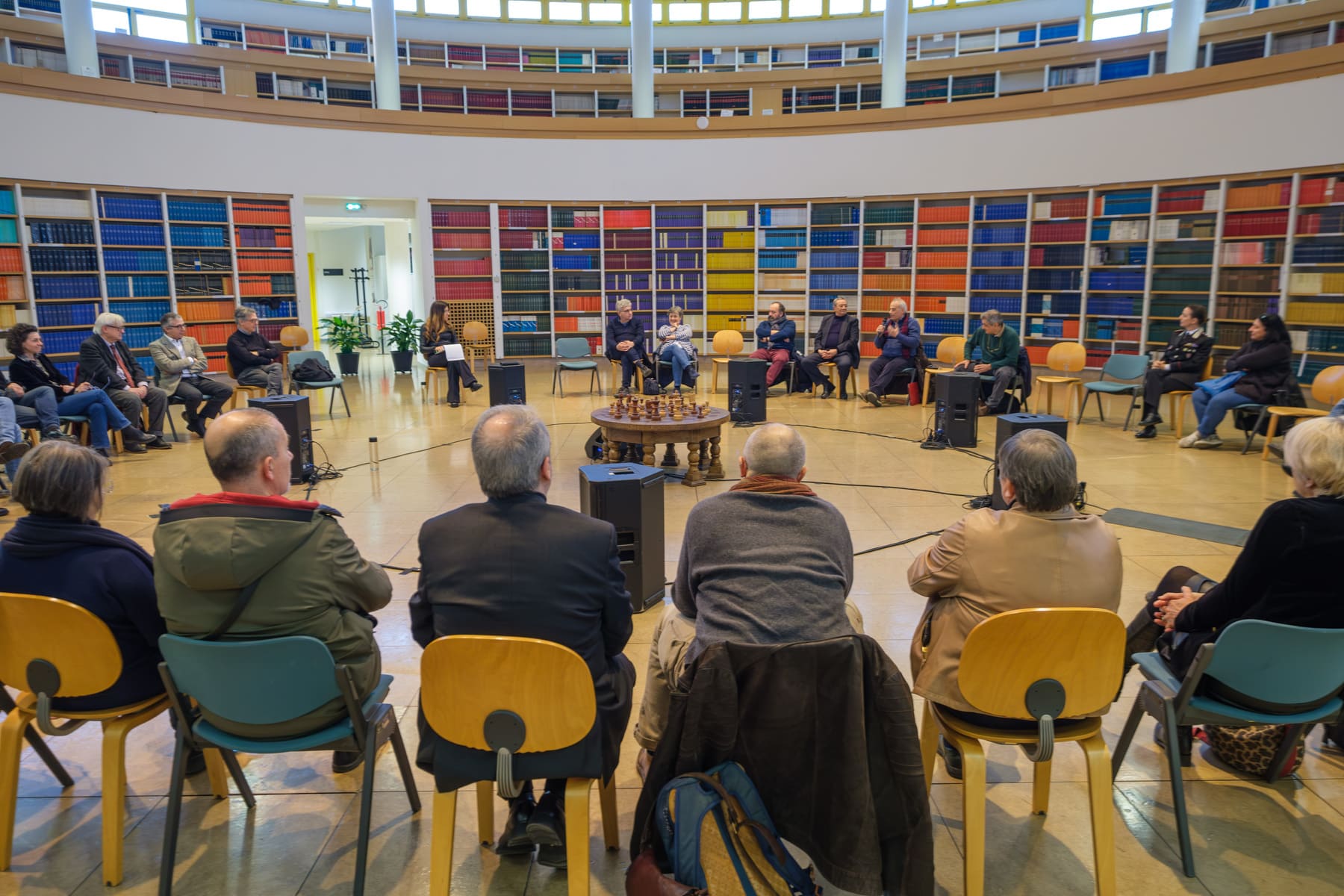
‘COSMIC SYNTROPY: WATER’ – Performance 3 Feb 2024
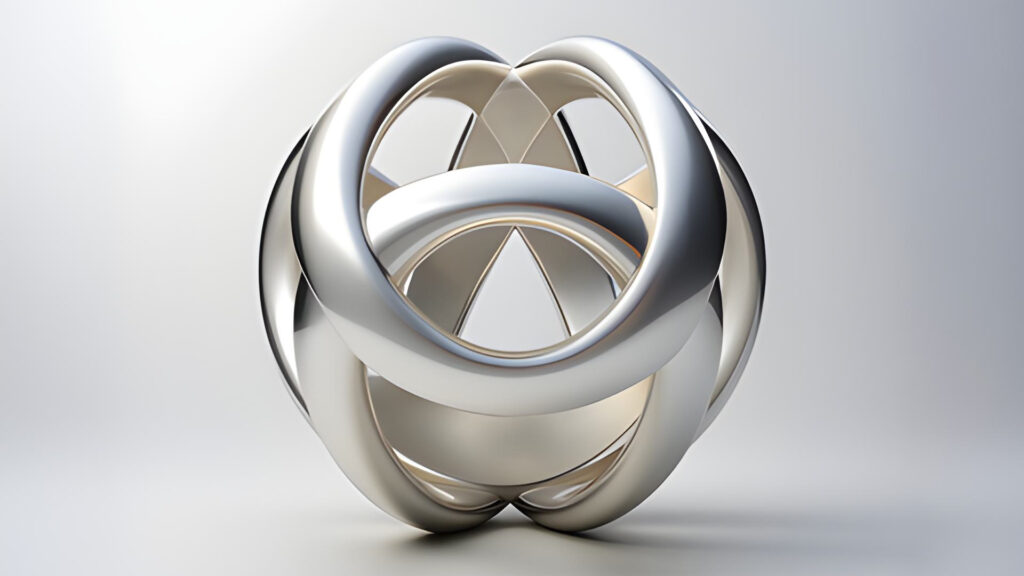
Curated by Giacinto Di Pietrantonio
Project in collaboration with Arts at CERN
Part of the Art City Bologna 2024 institutional calendar
“Dario Nobili” Library
CNR Italian National Research Council
Bologna Research Area
A cura di Giacinto Di Pietrantonio
Progetto in collaborazione con Arts at Cern
Nell’ambito del calendario istituzionale di Art City Bologna 2024
Biblioteca “Dario Nobili”
CNR Consiglio Nazionale delle Ricerche
Area Territoriale di Ricerca di Bologna
Type of performance: Participatory round table. Participants enter and exit freely by moving their chairs. They can speak waiting for their turn.
Duration: 5h 24m
Documentary video in the artist’s archive.
Tipologia di performance: Tavola rotonda di tipo partecipativo. I partecipanti entrano ed escono liberamente spostando la propria sedia. Possono intervenire attendendo il proprio turno.
Durata: 5h 24m
Video documentale in archivio dell’artista.
[/vc_column_text]
Reduced version of the documentary video – Versione ridotta del video documentale
Syntropy is opposed to entropy and indicates the tendency in nature to create differentiated and ordered structures, as seen in biological phenomena and human activities.
“Cosmic Syntropy” is an experimental project held at CNR’s “Dario Nobili” Library in Bologna, in collaboration with Arts at CERN, a programme aiming to forge closer links between art and science by CERN in Geneva, Europe’s nuclear research organisation.
The collection of artworks created for the “Cosmic Syntropy” project includes performances, documentary videos, and installations.
La sintropia si contrappone all’entropia, e indica la tendenza alla creazione in natura di strutture differenziate e ordinate, tipica dei fenomeni biologici e delle attività umane.
“Cosmic Syntropy” è un progetto sperimentale ospitato all’interno degli spazi della Biblioteca “Dario Nobili” del CNR di Bologna, nato dalla collaborazione con Arts at CERN, il programma dedicato al dialogo tra arte e scienza del CERN di Ginevra, l’organizzazione europea per la ricerca nucleare.
Il gruppo di opere realizzate per il progetto “Cosmic Syntropy” include performance, i relativi video documentali, e installazioni.
Critique by Giacinto Di Pietrantonio
During Bologna Art City, the annual public art exhibition held from 1 to 4 February as part of Arte Fiera in Bologna, artist Penelope Chiara Cocchi presented the first phase of her multidisciplinary, multi-stage art project. It is a complex artwork in which and with which the artist questions herself and us about the crucial issues of our being in the world, several of which coincide with the UN sustainable development goals to be achieved by 2030. These goals range from democracy to ecology, from resources and their redistribution to globalisation.
For this initial stage, held at CNR’s library in Bologna, the project focuses on the issue of water as a common and indispensable good coming from and belonging to our planet without which life, in all its forms, would cease to exist. The project employs a range of artistic methods, techniques and aspirations that fit into the modernist tradition with a public and social vocation channelled by artists such as Joseph Beuys or Michelangelo Pistoletto, who put the care of society at the centre of their work.
This is possible, to paraphrase artist Penelope Chiara Cocchi, if different forces are made to converge towards a single purpose, a common good, as is the case with syntropy, which, unlike entropy, which makes use of and enhances disorder, is a centripetal force that reorganises and orders the forces of nature’s complexity and differences, while at the same time striving to achieve the maximum configuration of order in differentiation.
This is why, for this initial stage, the artist’s Cosmic Syntropy proposes a collective work of objects, liquids and people engaging in dialogue about water. It is at once an installation and a performance in which specialists from various backgrounds come together: scientists, art critics, philosophers, sociologists, geographers, anthropologists, foresters, Latinists, Greekists… converge in a performance-discussion in a place not dedicated to art, but to scientific knowledge: the CNR library in Bologna. The scene is set with an installation of water bottles placed on pedestals each with a different label, from Mediterranean Sea Water to Japanese and Italian Alp Water, Mars water and even “dinosaur’s pee”. This metaphorical term, coined by scientists to describe the water of the world’s origins, is useful to illustrate that the water cycle has always been the same since time immemorial, so the water we drink today is the same water that the dinosaurs drank. Water is a common good that cyclically renews itself, but the cycle is not eternal and we must take care of this precious resource. This is why the artist has gathered together a group of unsuspecting authors from different disciplines to debate the issue of water. Authors who, as creators of meaning, are also questioned on the subject by both artist and audience.
Reflecting on the fact that content in art is substantiated in form, the artist placed the participants in a circle, thereby ensuring that their very conformation, arrangement and placement engendered a sense of egalitarian democracy of knowledge. A round table, rather than a confrontation, of syntropic knowledge that the artist wants to circulate. A circularity to mirror the roundness of the Earth itself, which was also emphasised by the chessboard placed at the centre with all equal pieces to further emphasise the equality of humanity.
Testo critico a cura di Giacinto Di Pietrantonio
In occasione di Bologna Art City, rassegna annuale di arte pubblica che si tiene dal 1 al 4 febbraio durante Arte Fiera a Bologna, l’artista Penelope Chiara Cocchi presenta la prima fase di un progetto artistico multidisciplinare in diverse tappe. È un’opera d’arte complessa in cui e con cui l’artista si interroga e ci interroga su tematiche cruciali del nostro stare al mondo; diverse delle quali sono gli obiettivi dello sviluppo sostenibile indicati dall’ONU da raggiungere entro il 2030. Sono traguardi che vanno dalla democrazia all’ecologia, dalle risorse e loro redistribuzione alla globalizzazione, …
In questa prima tappa, che si tiene presso la biblioteca del CNR di Bologna, il progetto si focalizza sulla problematica dell’acqua quale bene comune e indispensabile del e al nostro pianeta senza cui la vita, in tutte le sue forme, cesserebbe di esistere. Modalità, tecnica e aspirazioni artistiche che si inseriscono in quella tradizione modernista con vocazione pubblica e sociale di artisti come Joseph Beuys o Michelangelo Pistoletto che mettono al centro della loro poetica la cura della società.
Ciò è possibile, parafrasando l’artista Penelope Chiara Cocchi, se forze differenti vengono fatte convergere verso uno scopo unico, un bene comune, come avviene nella sintropia che, al contrario dell’entropia, che si serve e valorizza il disordine, è forza centripeta che riorganizza e ordina le forze della complessità e delle differenze della natura, cercando, allo stesso tempo, di raggiungere la massima configurazione d’ordine nella differenziazione.
È per ciò che l’artista con Cosmic Syntropy, in questa prima tappa, ci propone un’opera collettiva fatta di oggetti, fluidi e persone volti ad attivare discorsi intorno all’acqua. Si tratta di un’istallazione e di una performance in cui i discorsi di specialisti di vari mondi espressivi si incontrano: scienziati, critici d’arte, filosofi, sociologi, geografi, antropologi, forestali, latinisti, grecisti… convergono in una performance-discussione in un luogo non dedicato all’arte, ma del sapere scientifico come la biblioteca del Consiglio Nazionale delle Ricerche della città felsinea. Qui abbiamo l’installazione di gruppi di bottiglie d’acqua messi su piedistalli ognuno con un’etichetta diversa, dall’acqua del mar Mediterraneo a quella delle Alpi giapponesi, nonché alle Alpi italiane fino all’acqua di Marte e a quella “dinosaur’pee” (pipì del dinosauro). Quest’ultimo termine metafora, coniata dagli scienziati per definire l’acqua delle origini del mondo, parola utile per indicare che il ciclo dell’acqua è sempre lo stesso dalle origini e che quindi anche oggi, dato il riciclo, continuiamo a bere la stessa che bevevano i dinosauri. Acqua, bene comune che si rinnova ciclicamente, ma non eterno, di cui dobbiamo prenderci cura. Per questo l’artista chiama a raccolta un gruppo di insospettabili autori di discipline differenti a dibattere della problematica dell’acqua. Autori che da generatori di senso vengono anche interrogati sul tema sia dall’artista che dal pubblico.
E, dato che nell’arte il contenuto si sostanzia nella forma, la stessa conformazione, disposizione e collocazione dei partecipanti decisa dall’artista ha un senso di democrazia egalitaria dei saperi, essendo essi messi in circolo a discutere. Una tavola rotonda del sapere e non una frontalità dei saperi che qui, in quanto sintropici, l’artista vuole circolare. Una circolarità come la stessa rotonda Terra, sottolineata pure dalla scacchiera messa al centro con scacchi tutti uguali per evidenziare ulteriormente l’uguaglianza dell’umanità.
THE PERFORMANCE: PARTICIPATORY ART
The “Cosmic Syntropy: Water” performance, held on 3 February 2024 to coincide with the inauguration of the exhibition, is the second participatory performance in the project. The performance begins with the paradigms of the first (link here), but builds on it by entering into dialogue with citizens, who are thus brought into the artwork, creating a “parliament of human beings” staged by the artist. The duration of the performance depended on the audience: the rule was that the artist would stay as long as even one person was there. The performance lasted five and a half hours.
The entire performance was recorded and a documentary video is now available at the artist’s archive (duration 5:37:14 h).
LA PERFORMANCE: arte partecipativa
La performance “Cosmic Syntropy: Water” realizzata il 3 febbraio 2024, in concomitanza con l’inaugurazione della mostra è il secondo atto performativo del progetto, di natura partecipativa. Una performance che parte dai paradigmi della prima (link qui), ma si sviluppa in dialogo con la cittadinanza, che per l’occasione diventa protagonista dell’opera d’arte, del “parlamento di esseri umani” messo in scena dall’artista. La durata della performance sarebbe dipesa dal pubblico: la regola è che l’artista sarebbe rimasta finché ci sarebbe stata anche solo una persona. La performance è durata cinque ore e mezza.
L’intera performance è stata ripresa ed è stato prodotto il video documentale ora presso l’archivio dell’artista (durata 5:37:14 h).
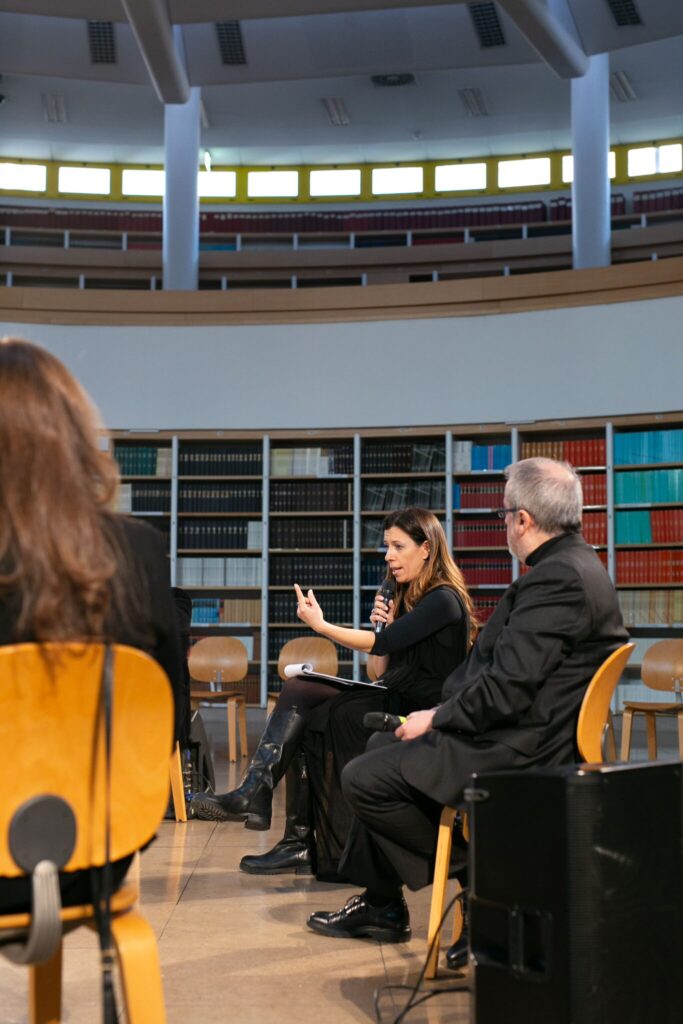
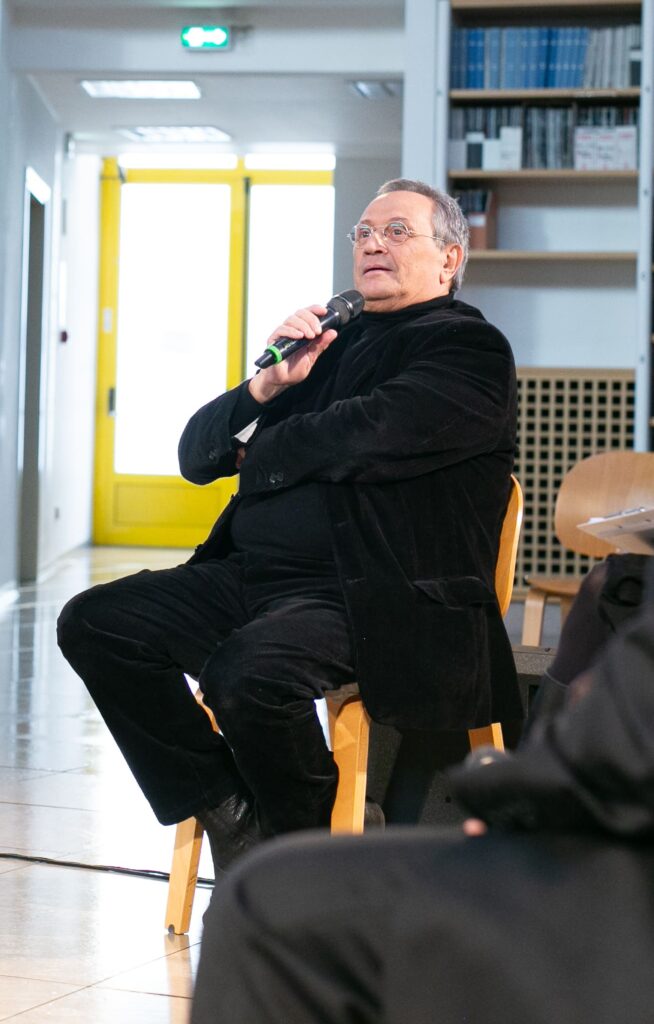
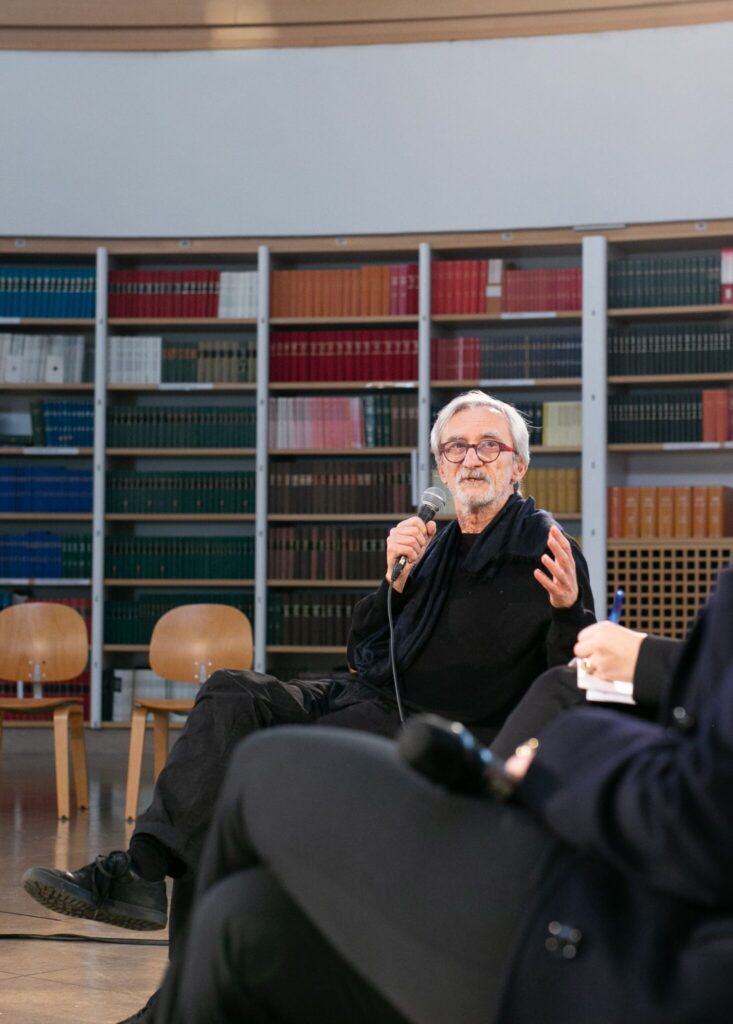
INTERVIEWS WITH SPEAKERS
In preparation for the round table discussion, the artist conducted a series of interviews with the invited speakers, to get to know the professionals involved and to explore the subject matter during the performance.
The interviews can be viewed at the following link: https://youtu.be/Zqn8Hc8hIb4.
INTERVISTE AGLI ORATORI
In preparazione della tavola rotonda l’artista ha realizzato una serie di interviste agli oratori invitati, con la finalità di conoscere le professionalità coinvolte e per entrare nell’argomento approfondito durante la performance.
Le interviste sono visionabili al seguente link: https://youtu.be/Zqn8Hc8hIb4.
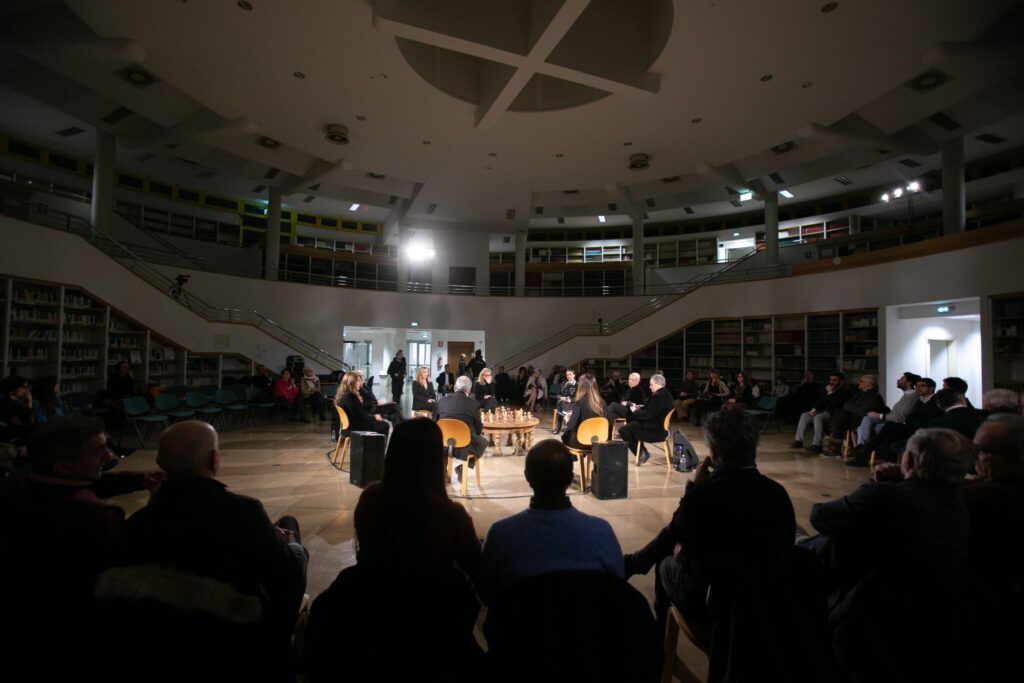
“BALANCE CHESSBOARD”
“Balance Chessboard” artwork placed at the centre of the room and at the centre of the round table. An impossible chessboard, circular in shape, with a single side instead of four, without factions to protect or teams to fight. A single team, stuck in the metaphor of a world balance, made possible today only thanks to the nations’ possession of the atomic bomb. A single human race, a single team, in a short circuit that does not allow any match, because the possible moves would lead to a shared defeat or… a shared victory.
Al centro della sala e al centro della tavola rotonda è esposta l’opera “Balance Chessboard”. Una scacchiera impossibile, di forma circolare, con un unico lato invece che quattro, senza fazioni da proteggere né squadre da combattere. Un’unica squadra, incastrata nella metafora di un equilibrio mondiale, reso possibile oggi solo grazie al possesso da parte delle nazioni della bomba atomica. Un unico genere umano, un’unica squadra, in un corto circuito che non le permette nessuna partita, perché le possibili mosse porterebbero a una comune sconfitta o… una comune vittoria.
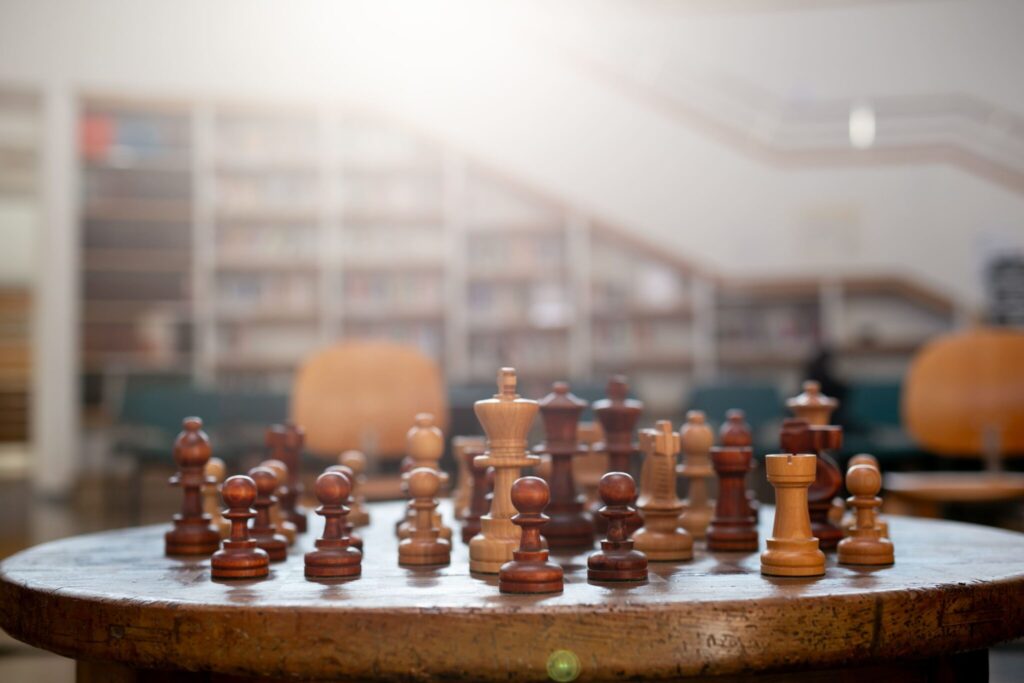
“Balance Chessboard”, installation, walnut wood table, pear and fig wood chess pieces, Ø111 cm x h 51 cm (+18,5 cm king chess piece), 2024.
“Balance Chessboard”, installazione, tavolo in legno di noce, pedine da scacchi in legno di pero e abete, Ø111 cm x h 51 cm (+18,5 cm pedina re scacchi), 2024.

“You are drinking Dinosaur’s Pee”, installation, Glass bottles, water, labels, variable size, 2024.
“You are drinking Dinosaur’s Pee”, installazione, bottiglie di vetro, acqua, etichette, dimensioni variabili, 2024.
“YOU ARE DRINKING DINOSAUR’S PEE”
The “Dinosaur’s Pee” installation is exhibited in the spaces around the central room. The work consists of a collection of bottles, each the same shape and size, bearing labels describing the origins of their contents. Each bottle contains clear water, and each label indicates its source.
The bottles are labelled as follows:
– Amniotic Fluid
– Mariana Trench Water
– Human tears
– Mediterranean Sea Water
– Italian Alps Water
– Japanese Alps Water
– Bering Sea Water
– Mars Water
– Flush water
– My neighbor’s swimming pool water
– Toilet Flush Water / Pure water
– Pure water
With its deliberately provocatory title, the work reflects on how the human microcosm is interconnected with the earthly macrocosm, on the relationship between humans and the natural world, creating vertical and horizontal connections. Science usually states ironically that “you are drinking dinosaur’s pee” to explain the origin and continuous internal recycling of our vital element. The reflection wilfully breaks the temporal sphere, going all the way back, through the title, to the beginning of history on Earth. The concept behind the series takes its cue from Lavoisier’s precept: “Nothing is lost, nothing is created, everything is transformed”. Science has proven that the water on Earth today is the same since the genesis, as it is created endogenously and exogenously (particles from the Cosmos), and constantly charged and purified by the nature of external elements.
The work entitled “You Are Drinking Dinosaur’s Pee” is the starting point of this exhibition, from which the subsequent works on show here originate and branch out.
The work is part of the “Dinosaur’s Pee” series > see dedicated section.
Negli spazi circostanti la sala centrale è esposta l’installazione “Dinosaur’s Pee”. L’opera è formata da una raccolta di bottiglie della stessa forma e dimensione che reca etichette con diverse scritte. Ogni bottiglia contiene acqua trasparente, e ogni etichetta indica l’origine di tale acqua.
Le diciture sulle etichette riportano:
– Amniotic Fluid
– Mariana Trench Water
– Human tears
– Mediterranean Sea Water
– Italian Alps Water
– Japanese Alps Water
– Bering Sea Water
– Mars Water
– Flush water
– My neighbor’s swimming pool water
– Toilet Flush Water / Pure water
– Pure water
Dal titolo volutamente provocatorio, l’opera riflette sulle connessioni tra il microcosmo umano e il macrocosmo terrestre, sul rapporto tra il genere umano e il mondo naturale, creando collegamenti di tipo verticale e orizzontale. La Scienza è solita affermare con ironia che “l’acqua che beviamo è la pipì dei dinosauri” per spiegare l’origine e il continuo riciclo interno del nostro elemento vitale. La riflessione rompe volutamente la sfera temporale, risalendo, grazie al titolo, all’inizio della storia della Terra. Il tema centrale della serie parte dagli studi di Lavoisier e cita simbolicamente le sue parole: “Nulla si crea, nulla si distrugge, tutto si trasforma”. La scienza ha dimostrato che l’acqua presente oggi sulla Terra è la stessa dalla genesi, poiché creatasi in modo endogeno ed esogeno (particelle provenienti dal Cosmo), e costantemente caricata e depurata dalla natura di elementi esterni.
L’opera “You Are Drinking Dinosaur’s Pee” rappresenta il punto di partenza della presente mostra, dal quale sono nate e si sono ramificate le successive opere qui esposte.
L’opera rientra nella serie “Dinosaur’s Pee” > vedi la sezione dedicata.

“You are drinking Dinosaur’s Pee”. Detail – dettaglio.
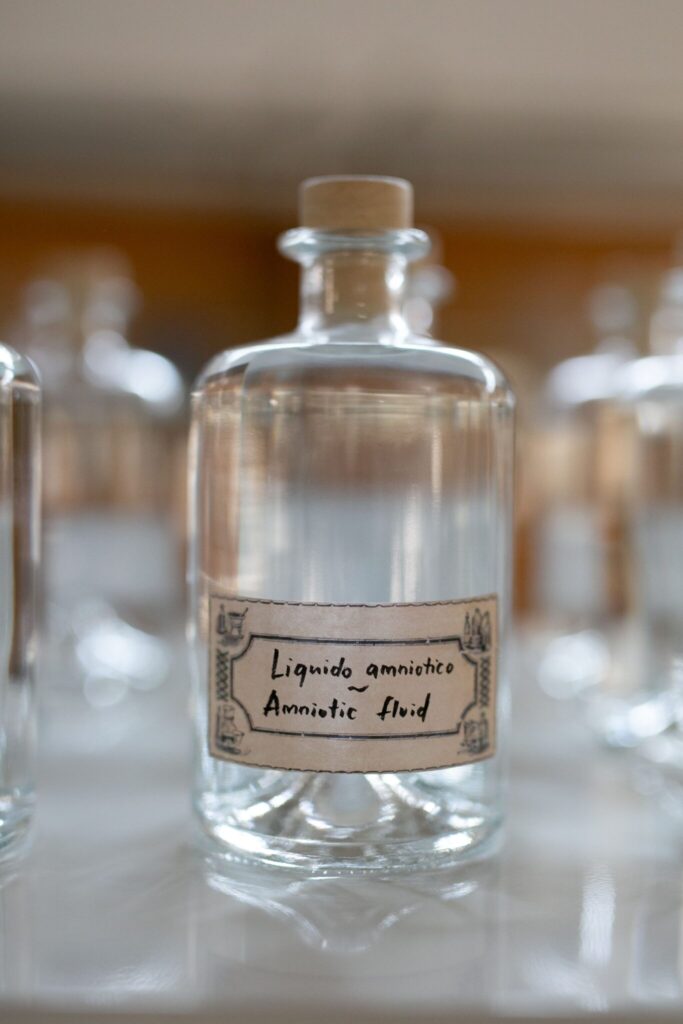
“You are drinking Dinosaur’s Pee”. Detail – dettaglio.



